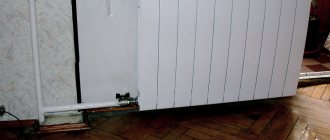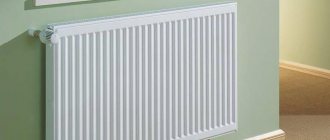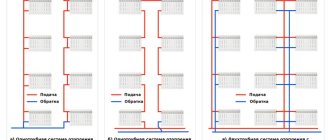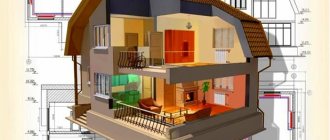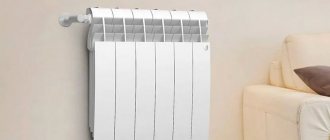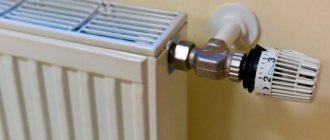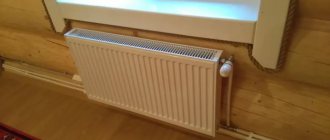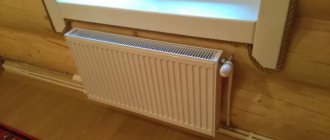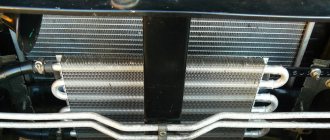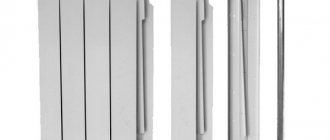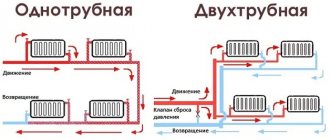The main criterion for choosing heating radiators is their heat transfer. However, the power indicator of the heating device depends not only on the material of manufacture, but also on the shape, design and development of the surface. Therefore, each model has an individual indicator.
In the article we will look at ways to correctly calculate the required battery power, compare the heat transfer rates of various types and models of heating radiators, and highlight the best and most efficient of them.
How to correctly calculate the actual heat transfer of batteries
First of all, study the technical data sheet of the battery. In it you will definitely find the parameters you are interested in - the thermal power of one section or an entire panel radiator of a certain standard size. Do not rush to admire the excellent performance of aluminum or bimetallic heaters; the figure indicated in the passport is not final and requires adjustment, for which you need to calculate the heat transfer.
Erroneous judgment: the power of aluminum radiators is the highest, because the heat transfer of copper and aluminum is the best among metals. The thermal conductivity of aluminum is really high, but the heat transfer process depends on many factors. The second nuance: heating devices are made of silumin - an aluminum alloy with silicon, whose performance is noticeably lower.
The heat transfer stated in the heating device passport corresponds to the truth when the difference between the average temperature of the coolant ( supply t t )/2 and the room air is 70 °C. The value is called temperature difference, denoted Δt. Calculation formula:
Let's substitute the known value of the temperature difference and get the following equation:
( t + t )/2 - t = 70 °C
Reference. In the documentation of products from different companies, the parameter Δt can be designated differently: dt, DT, and sometimes it is simply written “at a temperature difference of 70 °C.”
What heat transfer will we get if the documentation for a bimetallic radiator says: the thermal power of one section is 200 W at DT = 70 °C? The same formula will help you figure it out; we substitute the room temperature value of +22 °C into it and carry out the calculation in reverse order:
( t feed + t return) = (70 + 22) x 2 = 184 °C
Knowing that the temperature difference in the supply and return pipelines should not exceed 20 °C, we determine their values as follows:
- t = 184/2 + 10 = 102 °C;
- t = 184/2 – 10 = 82 °C.
Now it is clear that 1 section of the bimetallic radiator from the example will give off 200 W of heat, provided that the water in the supply pipeline is heated to 102 °C, and the air temperature in the room is up to +22 °C.
The first condition is impossible, since modern domestic boilers heat up to 80 °C (maximum). This means that the radiator section will never produce the declared 200 W of heat. And the temperature of the coolant in the system of a private house rarely rises above 70 ° C, then DT = 38 ° C, and not 70 degrees. That is, the real heat transfer of the device is half the rating.
Selection of the number of sections
When cast iron heating radiators are selected, heat transfer also depends on the technical features of the room in which they plan to install cast iron heating radiators. The calculation results for corner and non-corner rooms, as well as for those with different ceiling heights and window sizes, will differ significantly. Important parameters when determining the required power for batteries are:
- room area;
- ceiling height;
- room location (not corner/corner);
- floor;
- the presence of additional heating devices in the room (air conditioning, fireplace, etc.);
- number of windows in the room, their sizes, material of manufacture (wood, double-glazed windows);
- quality of house wall insulation (external, internal);
- the presence of an attic space and its thermal insulation.
It is impossible to independently take into account all the nuances and correctly calculate the necessary parameters without special knowledge, so for a design solution it is wiser to turn to specialists who are well versed in this issue.
Video about heat transfer from cast iron radiators:
Procedure for calculating heat transfer
So, the actual power of the heating battery is much less than declared, but to select it you need to understand how much. There is a simple way to do this: applying a reduction factor to the nameplate value of the heater’s thermal power. Below is a table of coefficients by which the declared heat transfer of the radiator is multiplied depending on the actual DT value:
The algorithm for calculating the real heat transfer of heating devices for your individual conditions is as follows:
- Determine what the temperature in the house and water in the system should be.
- Substitute these values into the formula and calculate your temperature difference Δt.
- Find in the table the coefficient corresponding to the found DT.
- Multiply the rated heat transfer value of the battery by it.
- Calculate the number of sections or entire heating devices to heat the room.
In the example given, the thermal power of 1 section of a bimetallic radiator will be 200 W x 0.48 = 96 W. To heat a room of 10 m² it will take approximately 1000 W of heat or 1000/96 = 10.4 ≈ 11 sections (we round up).
The presented table and calculation of the heat transfer of batteries should be used when the documentation indicates Δt equal to 70 °C. But it happens that manufacturers provide radiator power for other conditions, for example, at Δt = 50 °C. Then you can’t use coefficients; it’s easier to dial the required number of sections according to the passport characteristics, just take their number with a margin of one and a half.
Reference. Many manufacturers indicate heat transfer values under the following operating conditions: t = 90 °C, t = 70 °C, t = 20 °C, which exactly corresponds to Δt = 50 °C.
How much heat is needed for heating?
To accurately calculate the required amount of heat for a room, many factors should be taken into account : the climatic features of the area, the cubic capacity of the building, possible heat loss from the housing (the number of windows and doors, building material, the presence of insulation, etc.). This calculation system is quite labor-intensive and is used in rare cases .
Basically, the calculation of heat is determined on the basis of established indicative coefficients: for a room with ceilings no higher than 3 meters, 1 kW of thermal energy is required per 10 m2 . For the northern regions, the figure increases to 1.3 kW.
For example, a room with an area of 80 m2 requires 8 kW of power for optimal heating. For the northern regions, the amount of thermal energy will increase to 10.4 kW
Comparison by thermal power
If you carefully studied the previous section, you should understand that heat transfer is greatly influenced by air and coolant temperatures, and these parameters depend little on the radiator itself. But there is a third factor - the heat transfer surface area, here the design and shape of the product plays a big role. It is impossible to clearly compare a steel panel heater with a cast iron radiator; their surfaces are too different.
It is difficult to compare the heat output of flat panels and ribbed surfaces of complex configurations
The fourth factor influencing heat transfer is the material from which the heating device is made. Compare for yourself: 5 sections of the GLOBAL VOX aluminum radiator with a height of 600 mm will deliver 635 W at DT = 50 °C. A cast iron retro battery DIANA (GURATEC) for 5 sections of the same height will transmit only 530 W to the room under similar conditions (Δt = 50 °C). These data are published on the manufacturers' official websites.
Note. The power characteristics of aluminum and bimetallic heaters differ little; there is no point in comparing them.
You can try to compare aluminum with a steel panel radiator by taking the closest standard size that fits the dimensions. The length of a battery of 5 GLOBAL aluminum sections with a height of 600 mm will be approximately 400 mm, which corresponds to a KERMI 600 x 400 steel panel.
The table shows the thermal performance of 1 section made of aluminum and bimetal depending on the size and temperature difference Δt
Even if we take a three-row steel panel (type 30), we get 572 W at Δt = 50 °C versus 635 W for 5-section aluminum. Also keep in mind that the GLOBAL VOX radiator is much thinner, the depth of the device is 95 mm, and the KERMI panels are almost 160 mm. That is, the high heat transfer of aluminum sections makes it possible to reduce the dimensions of the heater.
In an individual heating system for a private home, batteries of the same power, made of different metals, will work differently. Therefore, the comparison is quite predictable:
- Bimetallic and aluminum products quickly heat up and cool down. By giving off more heat over a period of time, they cool the water returned to the system more.
- Steel panel radiators occupy a middle position, as they transfer heat less intensively. But they are cheaper and easier to install.
- The most inert and expensive are heaters made of cast iron; they are characterized by long heating and cooling, which causes a slight delay in the automatic regulation of coolant flow by thermostatic heads.
The conclusion is simple: it doesn’t matter what material the radiator is made of. The main thing is to choose the right battery in terms of power and design that suits the user. In general, for comparison, it would not hurt to become familiar with all the nuances of the operation of a particular device, as well as where it is better to install which one.
Aluminum radiators
Aluminum batteries do not have the same heat dissipation as bimetallic batteries. But still, aluminum heaters are not far from bimetallic radiators in terms of parameters. They are used most often in separate systems, because they are not often able to withstand the required amount of operating pressure. Yes, this type of heating device is used for operation in a central network, but only taking into account certain factors. One such condition involves the installation of a special boiler room with a pipeline. Then, aluminum heaters can be used in this system. But still, it is recommended to use them in separate systems in order to avoid unnecessary consequences. It is also worth noting that aluminum heaters are cheaper than previous batteries, which is a certain advantage of this type.
Comparison by other characteristics
One feature of battery operation – inertia – has already been mentioned above. But in order for the comparison of heating radiators to look objective, in addition to heat transfer, other important parameters should be taken into account:
- working and maximum coolant pressure;
- amount of water held;
- weight.
The operating pressure limitation determines whether the heating device can be installed in multi-storey buildings, where the height of water lifting by network pumps can reach hundreds of meters. The parameter does not matter for private houses, where the pressure in the system is low, maximum 3 Bar.
Comparing the capacity of radiators can give an idea of the total amount of water in the network that will have to be heated. Well, the weight of the product is important when choosing the installation location and method of attaching the battery.
As an example, below is a comparison table of the characteristics of various heating radiators of the same size:
Note. In the table, a heating device consisting of 5 sections is taken as 1 unit, except for the steel one, which is a single panel.
Comparative findings
As the table below compares the heat transfer of heating radiators shows, the most efficient in terms of power are bimetallic heaters.
Let us remind you that they are an aluminum finned body with a strong welded frame inside made of metal tubes for the flow of coolant. In all respects, this type of heater is suitable for installation both in heating networks of high-rise buildings and in private cottages. Their only drawback is their high cost. The heat transfer of aluminum radiators is slightly lower, although they are lighter and cheaper than bimetallic ones. In terms of test and operating pressure, aluminum devices can also be installed in buildings of any number of floors, but subject to: the presence of an individual boiler room with a water treatment unit. The fact is that aluminum alloy is susceptible to electrochemical corrosion from low-quality coolant inherent in central networks. It is better to install aluminum radiators in separate systems.
Cast iron radiators differ sharply from others, the heat transfer of which is significantly lower with a large mass and capacity of the sections. It would seem that with such a comparison they would not find application in modern heating systems. Nevertheless, the traditional MS-140 “accordion” continues to be in demand, their main trump card is durability and resistance to corrosion. Indeed, gray cast iron, from which MS-140 is made by casting, can easily serve for up to 50 years or more, and the coolant can be anything.
In addition, a conventional cast iron battery has high thermal inertia due to its massiveness and capacity. This means that when the boiler is turned off, the radiator remains warm for a long time. As for the operating pressure, cast iron heaters cannot boast of high strength. Purchasing them for networks with high water pressure is risky.
Design of bimetallic heaters
The body of these radiators is figured-ribbed, made of aluminum alloy, which is distinguished by excellent heat transfer. Under the housing there is a heating circuit made of pipes (copper or steel).
This “filling” helps the battery adequately withstand the attack of chemical and mechanical impurities present in hot water for heating.
The steel from which the core tubes are made is very strong. Therefore, the radiator will withstand even under high pressure. This can be 20, or even 40 atmospheres (some models up to 100 atmospheres). And the temperature of the coolant can rise to 110 or 130 degrees. If you need more specific numbers, you need to look at the passport of a specific radiator. Aluminum not only increases heat transfer, but also significantly makes the device lighter. In addition, the complex shaped housing has a very attractive design, giving the radiators an excellent appearance.
According to their characteristics, these radiators are quite suitable both for apartments in buildings of various heights, and for individual cottages with autonomous heating systems.
But don’t rush to the store right away - first we’ll tell you how to intelligently approach the issue of choosing them. Date: September 25, 2022
How to choose a frying pan for cooking different dishes
If you're not sure which frying pan you need, choose the pan that best suits the variety of dishes you typically cook.
Which frying pan allows you to cook without oil?
If you want to eat healthy, adding a minimal amount of oil when frying or cooking without it at all, give preference to pans that have a non-stick coating. The most suitable for healthy food are grill pans, stone, Teflon and ceramic products.
Pans for frying meat and steaks
A properly selected frying pan is already half the success of preparing a delicious meat dish. The product must withstand high temperatures and have a thick bottom and walls. If you like to fry large steaks, choose a large square-shaped frying pan. The presence of a relief bottom will allow you to cook meat with virtually no oil. At the same time, it is fried at high temperatures, practically without touching the bottom.
How to choose a pan for pancakes
The main condition for a pancake pan is low sides or their absence. Which product to choose with or without sides depends on the method of preparing pancakes (filled or distributed). In addition, take into account the thickness of the bottom; if it is too thin, it will quickly heat up and cool down, and as a result, the dough will either burn or fry unevenly. The best products for making pancakes are cast iron or aluminum frying pans with Teflon or ceramic coating.
